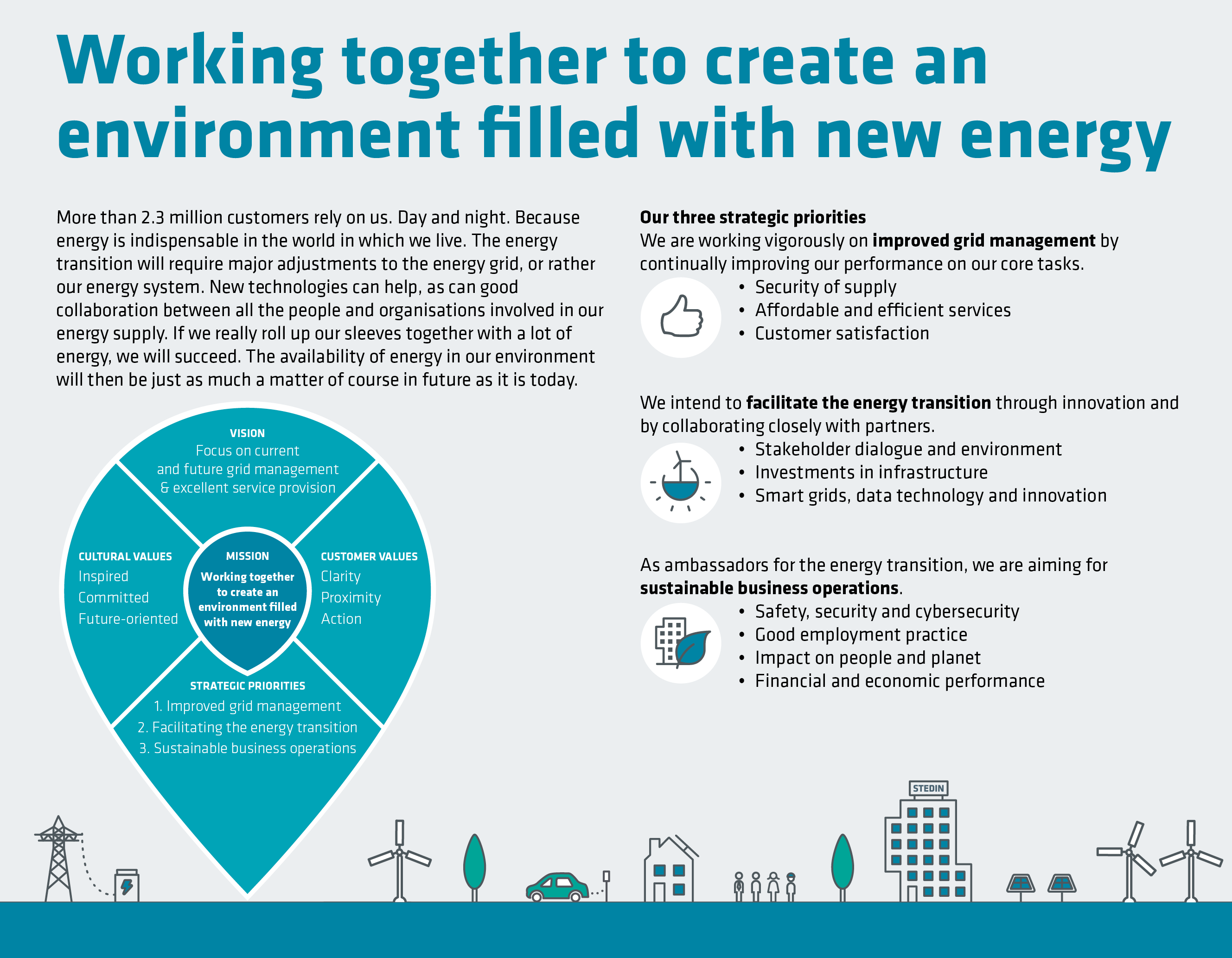Mission, vision and strategy, 2018-2022
Our current strategy has guided us over the past five years. By the time this annual report is published, the new strategy for the 2023-2027 will have been launched. ‘Working together to create an environment filled with new energy’: this is and will remain our mission. This annual report is structured around the same key drivers of the strategy for 2018-2022: Improved grid management, Facilitating the energy transition, and Sustainable business operations. Where possible, in this annual report we will also incorporate perspectives under our new strategy.

The 2018-2022 strategy in retrospect
Our position and prospects in 2018 were quite different from what they are today. Stedin had only just split off from Eneco to become an independent player. Since those first days as a ‘young’ organisation, Stedin has developed enormously. The energy transition was - and still is - a major driver of that development. We have had to reinvent ourselves as an organisation. In our strategy we chose to focus on our core tasks surrounding grid management and phasing out our commercial activities. For example, we sold Joulz in 2019. Following the take-over of DNWG, the grid management operations in Zeeland were also integrated into Stedin. In many respects we have been quite successful in achieving our goals.
Improved grid management
With our supply reliability score of 99.9959% we are still among the grid managers with the best grids in the world. We have worked hard to further improve the quality of our services. We connect 95% of our customers within 18 weeks from their application or on the desired date, compared with 58% in 2018. Over the same period, customer convenience improved from 74% to 81%. We also made several important steps in terms of efficiency. Of our savings programme worth €180 million, which runs up to and including 2025, we had already realised €166 million by the end of 2022.
Facilitating the energy transition
In order to facilitate the energy transition, we significantly increased our investment budget. Investments in our grids in 2022 were up 18% compared with 2018. Over the past five years, investments in our energy infrastructure totalled more than €3 billion. In 2022, our service area included three congestion areas. In collaboration with our customers and market parties, we are making every effort to limit congestion levels.
The energy transition is now well under way. In recent years we have seen our workload grow faster and faster due to adjustments to the climate targets. We have been quite successful in confronting this major challenge. For example, the number of charging points for retail consumers within our service area tripled relative to 2018.
We now also have more insight into our grids thanks to the completion of our Stedin Telecom Network with over 1,000 kilometres of new optical fibre connections. Nearly 85% of our customers now have a smart meter. Grid data has become far more easily accessible for our customers, market parties and municipalities. We can see that they use this data to make choices that are subsequently reflected in the Regional Energy Strategies and local plans and vision documents.
Sustainable business operations
As ambassador for the energy transition, we consistently aim for sustainable business operations. Safety has always been, and will always remain, our number one priority, as reflected in average RIF and LTIR scores of 0.86 and 1.3, respectively, over the past five years. With over 5,000 committed and passionate employees, we work day and night to ensure smooth energy supply processes in our service area. Our in-house training school enables us to attract and retain technical talent. Over the past five years, more than 800 employees obtained their senior secondary vocational education diplomas. We also worked hard to stay financially healthy. For example, in 2021 our shareholders contributed €200 million to our equity, and the State set aside a sum of €500 million to strengthen our capital position. Three times in recent years we successfully issued a green bond of €500 million. We allocated the amount raised to investments in the energy transition and in projects to make our vehicle fleet and our offices more sustainable. Our CO2 emissions fell by 49% compared with 2018. For example, 83% of our fleet of cars is now electric.
In conclusion, we can say that over the past five years we laid the foundations that are necessary to enable economic growth and a successful energy transition, both within our own operations and through our infrastructure. These foundations will help us build the future. More information on this is provided in Recalibration of the 2023-2027 strategy.

